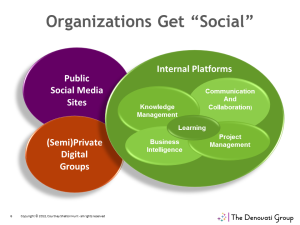A SMART Intranet in Every Company
When Herbert Hoover was running for President of the United States in 1928, one of the ad campaigns included the slogan, “A chicken in every pot, a car in every garage.” As a digital technology advocate, I am motivated to fulfil a comparable Digital Era promise, namely…
A (SMART) Intranet in Every Organization
I have always been comfortable with digital technology and liked to explore new ways that it could be used to communicate and collaborate. When I was a doctoral student in the mid-1990s, I was captivated by the potential of the World Wide Web and was fortunate to work with renowned organizational theorist Howard Aldrich to explore some of the concepts associated with that potential. It’s hard to believe that was almost 20 years ago…
Fast forward to 2008, when I read a Businessweek article about IBM’s internal use of social media and thought “this changes everything.” In what turns out to be an eerie coincidence, that article was dated May 21st – exactly one year before I established (practically on a whim!) the LinkedIn group that would become the Social Media in Organizations (SMinOrgs) Community, which would in turn officially get rebranded The Denovati Group exactly four years later.
During 2009 I gave presentations on the intra-organizational applications and implications of social media to a variety of groups and quickly realized that one of the biggest barriers to exploration and adoption on new technologies was leadership. In the winter of 2010, therefore, I started developing a Social Media Primer, which was primarily targeted to organizational leaders who were digital rookies. In Part 2 of the Primer, which was entitled, “The Juggernaut is Bigger than You Think,” I asserted the following:
The external applications of social media via public social networks may be garnering most of the attention today, but they represent the tip of a very large iceberg. When all is said and done, these applications will be dwarfed by all the other ways social media will impact how goals are achieved in organizations.
I have continued to make that same basic argument for the past 3 ½ years, as the presentation slide below reflects:

In Part 4 of the Primer, I addressed the organizational factors relevant to leveraging social technologies, arguing that organizational type, size, age and financial resources are less relevant than many people assume. More important factors include performance values like efficiency and effectiveness, productivity and financial performance, and innovation. And of course the most important factor is an organization’a strategy, in both the short and longer terms. Simply put, ALL organizations can benefit from leveraging social technologies to achieve their goals and objectives.
This doesn’t mean using Facebook, Twitter, or LinkedIn, however – especially for intra-organizational activities. As the diagram above indicates, social platforms range along what I call the privacy spectrum, from public social media sites to (semi) private groups to internal platforms. Although it’s tempting and many organizations have jumped on the bandwagon, public platforms like Facebook and LinkedIn are extremely poor choices for internal communication and collaboration, for reasons such as the following:
- Limited ability to monitor/control communication between staff and with other stakeholders.
- Challenges maintaining relationship boundaries (e.g., supervisor/subordinate).
- Limited control over design and features… and more importantly, virtually no control over – or even warning about – platform changes.
- Lack of real privacy; even if other users can’t access certain information/activity, the platform provider can – and does.
- No easy way to integrate activity in the various platforms, either within a platform or across platforms.
Fortunately, there are many alternatives to the public social media sites that not only offer much greater functionality but also get better every day. Moreover, many of them are extremely affordable, which means that even the smallest and most cash-strapped organizations can take advantage of tools and technologies that enable them to work smarter. And we’re not just talking about social software and social intranets. Recognizing rapid advances in and the proliferation of mobile devices and cloud-based computing, we’re also talking about hardware and networks and user design.
In my work as a consultant, I help organizations define their social computing and digital engagement needs, identify and evaluate their options, and design, develop and implement the selected solutions. In this work, I am constantly reminded that technology adoption and adaptation are fundamentally human endeavors. If we view technology as an engine, it’s the human factor that determines how smoothly and powerfully that engine runs – and for how long.
Interact’s 7 Pillars of a Successful Intranet reflect the importance of this human factor. Though they continually strive to develop a state-of-the-art technology solution, all of the seven pillars are focused on the non-technical factors that determine the effectiveness of implementing new socially- and digitally-driven ways of working. I’m looking forward to presenting two of those pillars – Key Considerations of a Useful Intranet and Day to Day Maintenance and Governance – at their half-day workshop in Manhattan on August 28th. And as a lifelong learner, I’m particularly keen to hear from the other speakers, as well as attendees, about the other pillars and more. Should be a great morning!
